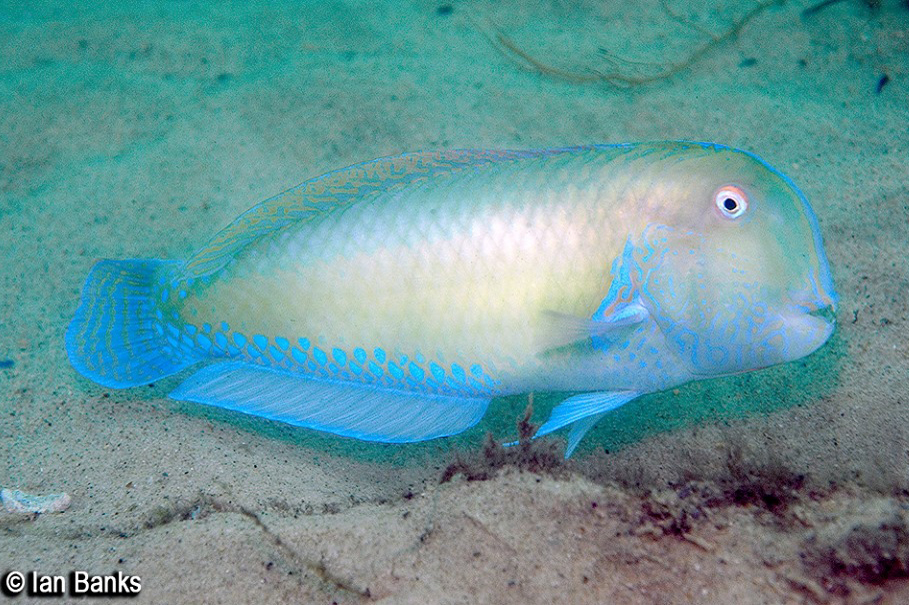- Classification
- ACTINOPTERYGII
- PERCIFORMES
- LABRIDAE
- Iniistius
- jacksonensis
Keelhead Razorfish, Iniistius jacksonensis (Ramsay 1881)
Other Names: Keel-head, Keelhead Wrasse, Keel-headed Parrotfish, Keelheaded Wrasse, Purple-spotted Wrasse

A Keelhead Razorfish, Iniistius jacksonensis, on the Gold Coast Seaway, southern Queensland, January 2015. Source: Ian Banks / iNaturalist.org. License: CC By Attribution-NonCommercial
Summary:
Species of the genus Iniistius have highly compressed bodies and a steep forehead with a firm knife-like anterior edge - enabling them to easily dive into the sand when threatened.
Cite this page as:
Bray, D.J. 2019, Iniistius jacksonensis in Fishes of Australia, accessed 27 Jun 2025, https://fishesofaustralia.net.au/Home/species/295
Keelhead Razorfish, Iniistius jacksonensis (Ramsay 1881)
More Info
|
Distribution |
North of Fraser Island, Queensland, to at least Sydney, New South Wales, and at Lord Howe Island in the Tasman Sea. Inhabits sandy areas, diving into the sand when threatened. |
|
Species Citation |
Novacula jacksonensis Ramsay 1881, Proc. Linn. Soc. N. S. W. 1 6(2): 198. Type locality: Manly Beach, Port Jackson, New South Wales. |
|
Author |
Bray, D.J. 2019 |
|
Resources |
Keelhead Razorfish, Iniistius jacksonensis (Ramsay 1881)
References
Allen, G.R., Hoese, D.F., Paxton, J.R., Randall, J.E., Russell, B.C., Starck, W.A., Talbot, F.H. & Whitley, G.P. 1976. Annotated checklist of the fishes of Lord Howe Island. Records of the Australian Museum 30(15): 365-454 figs 1-2 DOI: 10.3853/j.0067-1975.30.1976.287 Open access (as Hemipteronotus sp.)
Francis, M.P. 1993. Checklist of the coastal fishes of Lord Howe, Norfolk, and Kermadec Islands, Southwest Pacific Ocean. Pacific Science 47(2): 136-170. (as Xyrichtys jacksonensis)
Fukui, Y. 2019. Redescription of Iniistius jacksonensis (Ramsay 1881) and description of Iniistius opalus sp. nov. from northern Australia (Perciformes: Labridae). Ichthyological Research 66(2): 258-268. pp. https://doi.org/10.1007/s10228-018-0673-0
Johnson, J.W. 1999. Annotated checklist of the fishes of Moreton Bay, Queensland, Australia. Memoirs of the Queensland Museum 43(2): 709-762.(as Xyrichtys jacksonensis)
Johnson, J.W. 2010. Fishes of the Moreton Bay Marine Park and adjacent continental shelf waters, Queensland, Australia. pp. 299-353 in Davie, P.J.F. & Phillips, J.A. Proceedings of the Thirteenth International Marine Biological Workshop, The Marine Fauna and Flora of Moreton Bay. Memoirs of the Queensland Museum 54(3)
Kuiter, R.H. 1993. Coastal Fishes of South-eastern Australia. Bathurst : Crawford House Press 437 pp. (as Xyrichtys jacksonensis)
Kuiter, R.H. 2010. Labridae fishes: wrasses. Seaford, Victoria, Australia : Aquatic Photographics 398 pp. (as Xyrichtys jacksonensis)
Marshall, T.C. 1964. Fishes of the Great Barrier Reef and Coastal Waters of Queensland. Sydney : Angus & Robertson 566 pp. 136 pls.
Pollard, J. (ed.) 1980. G.P. Whitley's Handbook of Australian Fishes. North Sydney : Jack Pollard Publishing Pty Ltd 629 pp.
Ramsay, E.P. 1881. Description of a new labroid fish of the genus Novacula from Port Jackson. Proceedings of the Linnean Society of New South Wales 1 6(2): 198-199. See ref at BHL
Randall, J.E. & Earle, J.L. 2002. Review of the Hawaiian razorfishes of the genus Iniistius (Perciformes: Labridae). Pacific Science 56(4): 389-402.
Randall, J.E. , Earle, J.L. & Robertson, D.R. 2002. Iniistius auropunctatus, a new razorfish (Perciformes: Labridae) from the Marquesas Islands. Cybium 26(2): 93-98
Russell, B. 2010. Iniistius jacksonensis. The IUCN Red List of Threatened Species 2010: e.T187814A8635865. http://dx.doi.org/10.2305/IUCN.UK.2010-4.RLTS.T187814A8635865.en. Downloaded on 09 January 2019.
Thomson, J.M. 1978. A Field Guide to the Common Sea & Estuary Fishes of Non-tropical Australia. Sydney : Collins 144 pp.
Waite, E.R. 1899. Scientific results of the trawling expedition of H.M.C.S. Thetis off the coast of New South Wales. Memoirs of the Australian Museum 4: 1-132 figs 1-10 pls 1-31 (as Novaculichthys jacksonensis)



